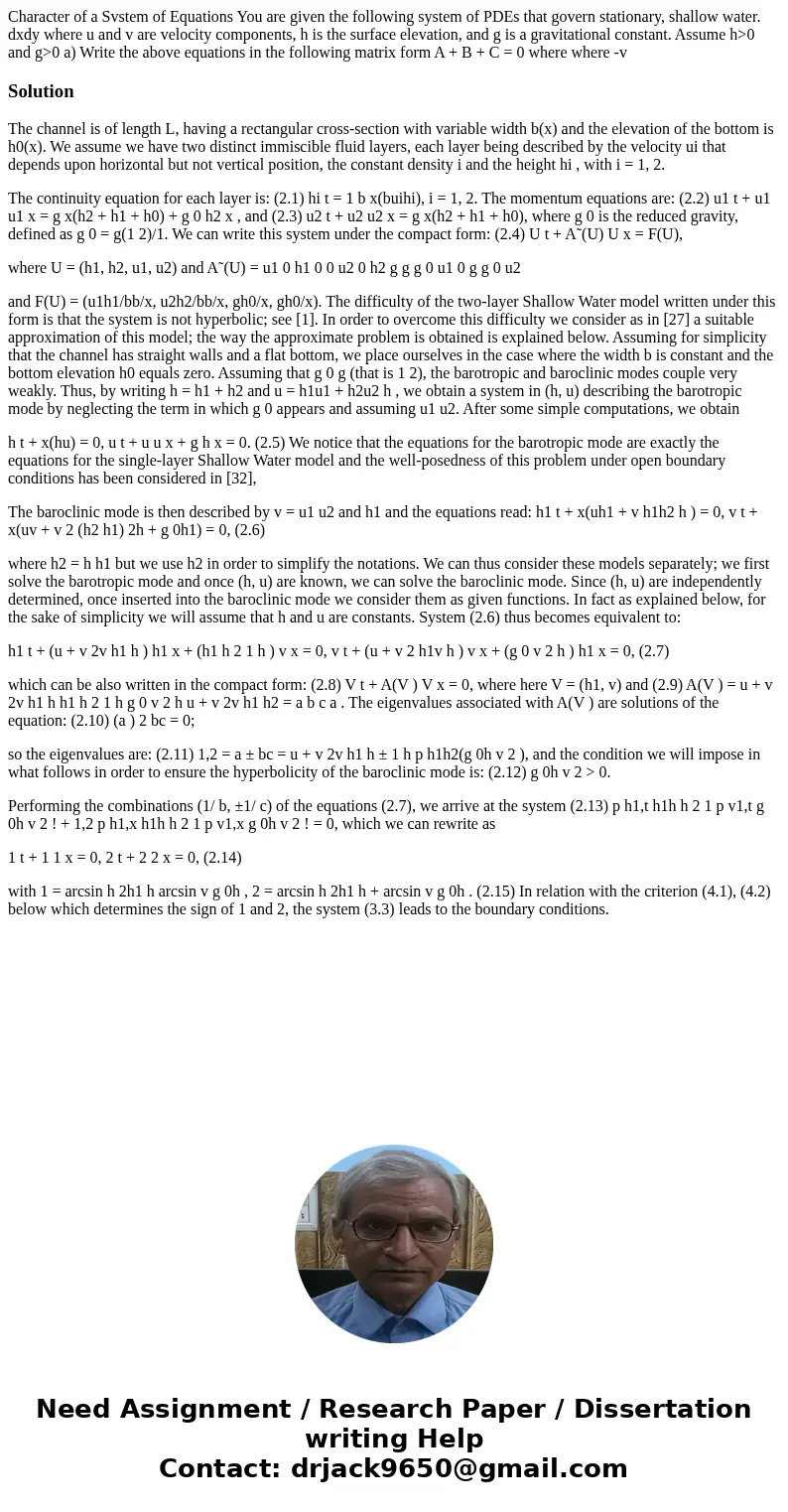Character of a Svstem of Equations You are given the followi
Solution
The channel is of length L, having a rectangular cross-section with variable width b(x) and the elevation of the bottom is h0(x). We assume we have two distinct immiscible fluid layers, each layer being described by the velocity ui that depends upon horizontal but not vertical position, the constant density i and the height hi , with i = 1, 2.
The continuity equation for each layer is: (2.1) hi t = 1 b x(buihi), i = 1, 2. The momentum equations are: (2.2) u1 t + u1 u1 x = g x(h2 + h1 + h0) + g 0 h2 x , and (2.3) u2 t + u2 u2 x = g x(h2 + h1 + h0), where g 0 is the reduced gravity, defined as g 0 = g(1 2)/1. We can write this system under the compact form: (2.4) U t + A˜(U) U x = F(U),
where U = (h1, h2, u1, u2) and A˜(U) = u1 0 h1 0 0 u2 0 h2 g g g 0 u1 0 g g 0 u2
and F(U) = (u1h1/bb/x, u2h2/bb/x, gh0/x, gh0/x). The difficulty of the two-layer Shallow Water model written under this form is that the system is not hyperbolic; see [1]. In order to overcome this difficulty we consider as in [27] a suitable approximation of this model; the way the approximate problem is obtained is explained below. Assuming for simplicity that the channel has straight walls and a flat bottom, we place ourselves in the case where the width b is constant and the bottom elevation h0 equals zero. Assuming that g 0 g (that is 1 2), the barotropic and baroclinic modes couple very weakly. Thus, by writing h = h1 + h2 and u = h1u1 + h2u2 h , we obtain a system in (h, u) describing the barotropic mode by neglecting the term in which g 0 appears and assuming u1 u2. After some simple computations, we obtain
h t + x(hu) = 0, u t + u u x + g h x = 0. (2.5) We notice that the equations for the barotropic mode are exactly the equations for the single-layer Shallow Water model and the well-posedness of this problem under open boundary conditions has been considered in [32],
The baroclinic mode is then described by v = u1 u2 and h1 and the equations read: h1 t + x(uh1 + v h1h2 h ) = 0, v t + x(uv + v 2 (h2 h1) 2h + g 0h1) = 0, (2.6)
where h2 = h h1 but we use h2 in order to simplify the notations. We can thus consider these models separately; we first solve the barotropic mode and once (h, u) are known, we can solve the baroclinic mode. Since (h, u) are independently determined, once inserted into the baroclinic mode we consider them as given functions. In fact as explained below, for the sake of simplicity we will assume that h and u are constants. System (2.6) thus becomes equivalent to:
h1 t + (u + v 2v h1 h ) h1 x + (h1 h 2 1 h ) v x = 0, v t + (u + v 2 h1v h ) v x + (g 0 v 2 h ) h1 x = 0, (2.7)
which can be also written in the compact form: (2.8) V t + A(V ) V x = 0, where here V = (h1, v) and (2.9) A(V ) = u + v 2v h1 h h1 h 2 1 h g 0 v 2 h u + v 2v h1 h2 = a b c a . The eigenvalues associated with A(V ) are solutions of the equation: (2.10) (a ) 2 bc = 0;
so the eigenvalues are: (2.11) 1,2 = a ± bc = u + v 2v h1 h ± 1 h p h1h2(g 0h v 2 ), and the condition we will impose in what follows in order to ensure the hyperbolicity of the baroclinic mode is: (2.12) g 0h v 2 > 0.
Performing the combinations (1/ b, ±1/ c) of the equations (2.7), we arrive at the system (2.13) p h1,t h1h h 2 1 p v1,t g 0h v 2 ! + 1,2 p h1,x h1h h 2 1 p v1,x g 0h v 2 ! = 0, which we can rewrite as
1 t + 1 1 x = 0, 2 t + 2 2 x = 0, (2.14)
with 1 = arcsin h 2h1 h arcsin v g 0h , 2 = arcsin h 2h1 h + arcsin v g 0h . (2.15) In relation with the criterion (4.1), (4.2) below which determines the sign of 1 and 2, the system (3.3) leads to the boundary conditions.

 Homework Sourse
Homework Sourse